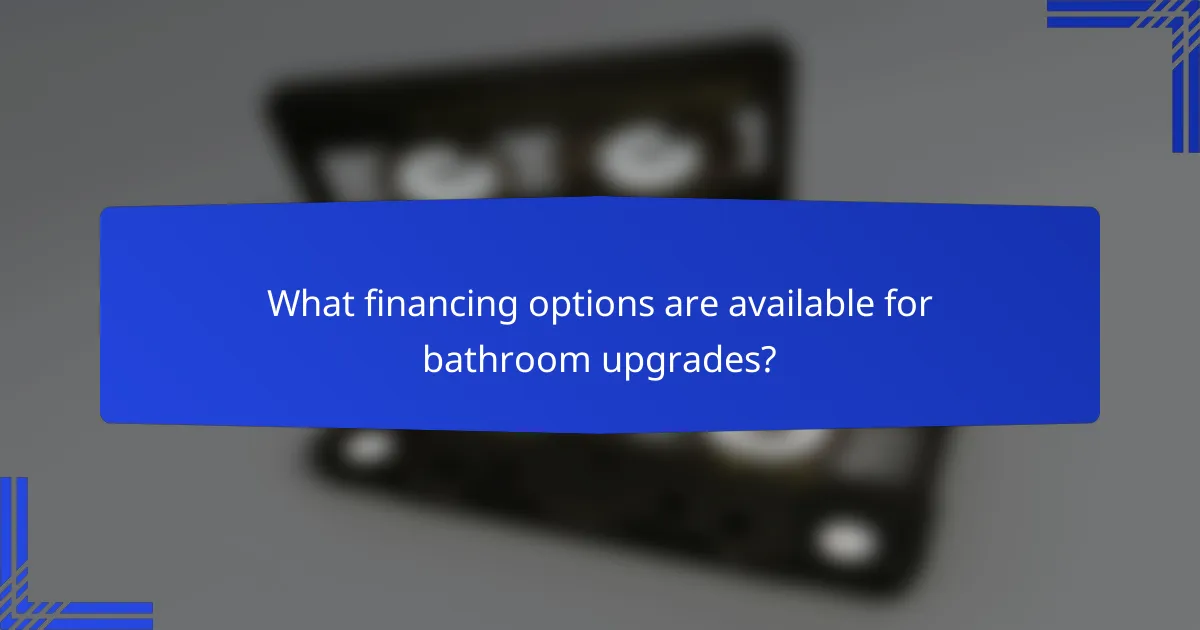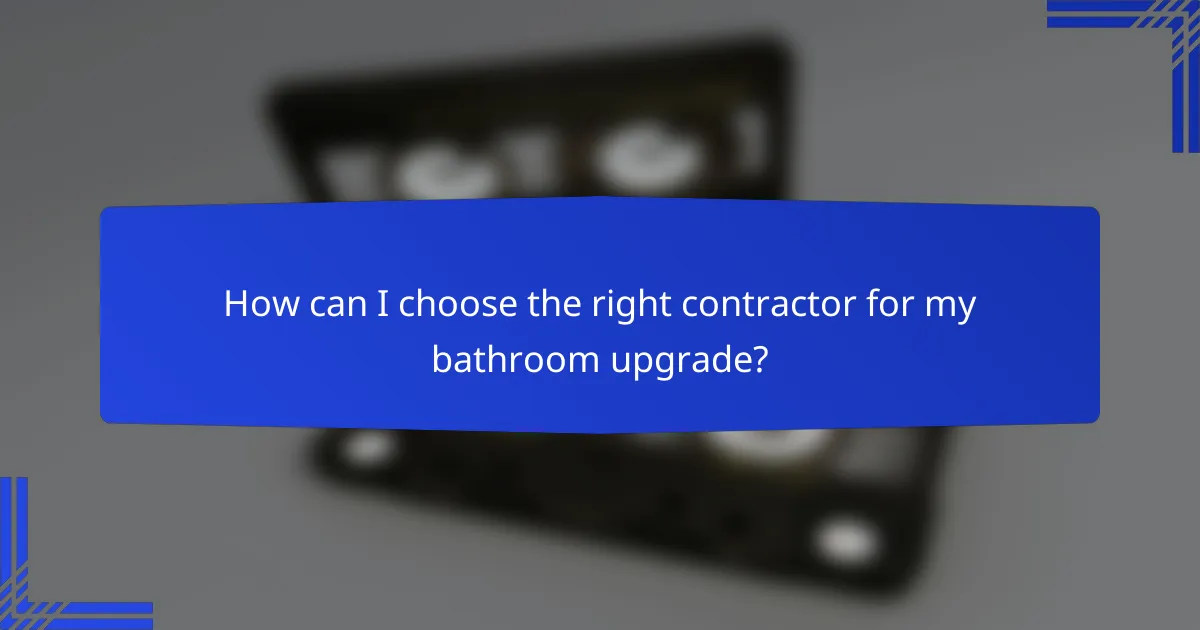Upgrading your bathroom can significantly enhance both its functionality and aesthetic appeal, with average costs in the UK ranging from £3,000 to £10,000 based on the scope of the renovation. To finance your project, options such as personal loans, home equity loans, and credit card financing are available, each with varying terms and suitability. Selecting the right materials, including tiles, countertops, and fixtures, is crucial for achieving a balance between style and durability while staying within budget.

What are the average costs of a bathroom upgrade in the UK?
The average costs of a bathroom upgrade in the UK typically range from £3,000 to £10,000, depending on the extent of the renovation and the materials used. A full remodel, including fixtures and finishes, can push costs higher, especially in larger spaces.
Cost breakdown by project type
Different types of bathroom upgrades come with varying costs. A simple refresh, such as repainting and replacing fixtures, may cost around £1,000 to £3,000. A mid-range remodel, which includes new tiles and a bathtub, can range from £5,000 to £8,000, while a high-end renovation with luxury materials can exceed £10,000.
Average cost per square meter
The average cost per square meter for a bathroom upgrade in the UK is typically between £300 and £600. This range can vary based on the quality of materials and the complexity of the installation. For example, high-end tiles and custom cabinetry will increase the cost per square meter significantly.
Factors influencing costs
Several factors can influence the overall costs of a bathroom upgrade. The choice of materials, labor costs in your area, and the existing plumbing and electrical systems can all affect the final price. Additionally, unexpected issues, such as water damage or outdated wiring, may lead to increased expenses during the renovation process.
It’s also essential to consider the design and layout changes you wish to implement. Moving plumbing fixtures or altering the layout can significantly increase both labor and material costs. Planning ahead and setting a realistic budget can help manage these expenses effectively.

What financing options are available for bathroom upgrades?
Several financing options can help cover the costs of bathroom upgrades, including personal loans, home equity loans, and credit card financing. Each option has its own terms, interest rates, and suitability depending on your financial situation and the scale of your project.
Personal loans for home improvement
Personal loans are unsecured loans that can be used for various purposes, including home improvements like bathroom upgrades. They typically offer fixed interest rates and repayment terms ranging from three to seven years.
When considering a personal loan, check your credit score, as it significantly affects the interest rate you may receive. Interest rates can vary widely, often falling between 5% and 36%, depending on your creditworthiness.
Home equity loans
Home equity loans allow homeowners to borrow against the equity they have built in their property. This type of loan usually has lower interest rates compared to personal loans, often ranging from 3% to 8%, since the loan is secured by your home.
To qualify for a home equity loan, lenders typically require a minimum of 15% to 20% equity in your home. Be cautious, as failing to repay the loan could result in losing your home.
Credit card financing
Using credit cards for bathroom upgrades can be a convenient option, especially for smaller projects. Many credit cards offer promotional interest rates, such as 0% APR for a limited time, which can help you manage costs effectively.
However, be mindful of the potential for high-interest rates once the promotional period ends. It’s advisable to pay off the balance before the regular rates kick in, which can range from 15% to 25% or more. Consider using a credit card with rewards or cashback benefits to maximize your financing strategy.

What materials should I consider for a bathroom upgrade?
When upgrading a bathroom, consider materials that enhance aesthetics, durability, and functionality. Key choices include tiles, countertops, and fixtures that align with your design preferences and budget.
Popular tile options
Tiles are a staple in bathroom upgrades due to their water resistance and variety. Ceramic and porcelain tiles are commonly used for floors and walls, offering durability and ease of maintenance. Natural stone tiles, such as marble or granite, provide a luxurious look but may require more upkeep.
When selecting tiles, consider the size and layout of your space. Larger tiles can create an illusion of spaciousness, while smaller tiles may be better for intricate designs. Prices can range from a few dollars per square foot for ceramic to significantly higher for natural stone.
Durable countertop materials
Countertops in bathrooms need to withstand moisture and daily use. Quartz and granite are popular choices due to their durability and resistance to stains. Laminate is a more budget-friendly option, though it may not offer the same longevity as stone surfaces.
When choosing a countertop, think about maintenance and style. Quartz requires less upkeep than granite, which needs periodic sealing. Prices typically vary, with laminate starting lower and natural stone options reaching higher price points, often in the hundreds of dollars per square foot.
Water-efficient fixtures
Water-efficient fixtures are essential for modern bathroom upgrades, helping to conserve water and reduce utility bills. Look for faucets, showerheads, and toilets that are labeled with the WaterSense certification, indicating they meet efficiency standards.
Installing low-flow fixtures can significantly lower water usage, often by 20-30%. While the upfront cost may be higher, the long-term savings on water bills can make them a wise investment. Consider the aesthetic appeal of fixtures as well, as they can enhance the overall design of your bathroom.

How can I choose the right contractor for my bathroom upgrade?
Choosing the right contractor for your bathroom upgrade involves assessing their experience, reputation, and fit for your specific project. It’s essential to ask the right questions, verify credentials, and compare quotes to ensure you make an informed decision.
Questions to ask potential contractors
When interviewing potential contractors, focus on their experience with bathroom upgrades and ask for references from previous clients. Inquire about their project timelines, availability, and how they handle unexpected issues that may arise during renovations.
Additionally, ask about their approach to permits and local regulations, as compliance is crucial for a successful upgrade. Understanding their payment structure and warranty offerings can also provide insight into their reliability and professionalism.
Checking contractor credentials
Verify that the contractor holds the necessary licenses and insurance required in your area, which protects you from liability in case of accidents. Check for any complaints or disciplinary actions through local consumer protection agencies or online reviews.
It’s also beneficial to confirm their membership in professional organizations, which can indicate a commitment to industry standards and ongoing education. A reputable contractor should be willing to provide proof of credentials upon request.
Comparing contractor quotes
When comparing quotes from different contractors, ensure that each estimate includes a detailed breakdown of costs, including materials, labor, and any additional fees. This transparency helps you understand what you are paying for and allows for a fair comparison.
Look for quotes that outline the scope of work clearly, as vague estimates can lead to misunderstandings later. Be cautious of quotes that are significantly lower than others, as they may indicate subpar materials or rushed work.

What are the latest trends in bathroom design in the UK?
Current trends in UK bathroom design focus on integrating technology, sustainability, and spaciousness. Homeowners are increasingly seeking modern solutions that enhance both functionality and aesthetics.
Smart bathroom technology
Smart bathroom technology includes features like automated lighting, smart showers, and heated floors, all designed to improve convenience and comfort. These innovations can often be controlled via smartphone apps, allowing users to customize their bathroom experience.
When considering smart technology, assess compatibility with existing systems and the potential for energy savings. For example, smart mirrors can provide lighting adjustments and display information like weather updates, enhancing daily routines.
Eco-friendly materials
Eco-friendly materials are gaining popularity as homeowners look to reduce their environmental impact. Options include recycled tiles, bamboo vanities, and low-VOC paints, which contribute to healthier indoor air quality.
Choosing sustainable materials often involves a trade-off between cost and longevity. While eco-friendly products may have a higher upfront cost, they can lead to savings in energy and maintenance over time, making them a worthwhile investment.
Open-concept layouts
Open-concept layouts are becoming a favored choice in bathroom design, promoting a sense of space and flow. This style often combines the bathroom with adjacent areas, such as bedrooms or dressing rooms, creating a more integrated living environment.
When planning an open-concept bathroom, consider privacy and ventilation. Using glass partitions or strategically placed plants can help maintain separation while still embracing the openness of the design. This approach can also enhance natural light, making the space feel larger and more inviting.

How can I maximize my bathroom upgrade budget?
To maximize your bathroom upgrade budget, focus on essential improvements that enhance functionality and aesthetics without overspending. Prioritize your needs, consider DIY options, and time your renovation strategically to take advantage of discounts and seasonal sales.
Prioritizing essential upgrades
Identify which upgrades will provide the most value and satisfaction. Common priorities include replacing outdated fixtures, improving lighting, and enhancing storage solutions. Allocate a larger portion of your budget to these essential upgrades while keeping cosmetic changes, like paint or decor, to a minimum.
Consider the return on investment for each upgrade. For instance, modernizing a bathroom can yield a significant return when selling a home, often recouping a substantial percentage of the renovation costs. Focus on upgrades that appeal to potential buyers, such as energy-efficient fixtures and quality materials.
DIY vs. professional help
Deciding between DIY and hiring professionals can significantly impact your budget. If you have basic skills, consider tackling smaller projects like painting or installing fixtures yourself to save on labor costs. However, for complex tasks such as plumbing or electrical work, hiring a licensed professional is advisable to ensure safety and compliance with local regulations.
Evaluate the cost of materials and tools needed for DIY projects against the cost of professional services. Sometimes, the savings from doing it yourself can be offset by the time and potential mistakes involved. Make a list of tasks you can confidently handle and those that require expert assistance.
Timing your renovation for savings
Timing your bathroom renovation can lead to significant savings. Consider scheduling your project during off-peak seasons, such as late fall or winter, when contractors may offer lower rates due to reduced demand. Additionally, keep an eye out for holiday sales and clearance events at home improvement stores for discounted materials.
Plan your renovation around local market trends. For example, if you live in an area where home sales peak in spring, start your upgrades in winter to avoid the rush and secure better pricing. Being strategic about timing can help stretch your budget further and enhance the overall value of your upgrade.
